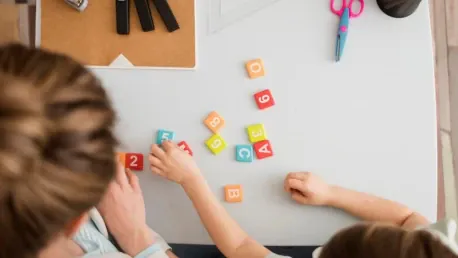Districts across the nation are making significant investments in constructing schools specifically designed for 4-year-olds. These facilities are tailored to meet the unique needs and developmental stages of young children, creating environments that foster learning through play. One notable example is the Jefferson Early Learning Center in Alief Independent School District, Houston. This school stands out from traditional elementary schools with its innovative design and focus on play-based learning.
The Unique Design of Jefferson Early Learning Center
Child-Centric Classrooms
Jefferson Early Learning Center features classrooms that deviate from conventional setups. Instead of traditional desks, the classrooms are adorned with child-sized boats, construction vehicles, and outer space-themed ceilings. This design encourages learning through play, which is crucial for young children’s development. The windows are positioned low, allowing children easy access to outside views, and the gym floor is made from layered vinyl to cushion falls. In such a setting, children are provided with a sense of comfort and security as they explore their surroundings, learning through engaging and hands-on activities.
The classrooms at Jefferson are a stark contrast to traditional learning environments, placing a strong emphasis on creativity and interaction rather than passive learning. By eliminating conventional desk setups, children are given the freedom to roam and interact with their space, fostering both cognitive and social development. The outer space-themed ceilings and child-sized structures initiate a sense of wonder and curiosity, which are essential for stimulating young minds. This approach recognizes the necessity for movement and physical exploration in early education, directly contributing to children’s overall physical and mental well-being.
Engaging Transitional Areas
The hallways at Jefferson are lined with corrugated plastic, which is engaging for young, exploratory fingers. These design elements create a sense of ownership and enthusiasm among the students, as noted by teacher Cathy Delamore. The overall environment is tailored to the needs of 4- and 5-year-olds, making it a welcoming and stimulating space for early learners. The emphasis on sensory engagement extends beyond the classroom, ensuring that every part of the school contributes to the children’s developmental journey.
The design philosophy of Jefferson Early Learning Center highlights the importance of consistent sensory and intellectual stimulation. Transitional areas are not mere corridors but interactive spaces that encourage exploration and tactile engagement. Hallways lined with corrugated plastic serve as more than passageways—they become spaces for sensory play, engaging young children in their environment even as they move from one activity to another. This thoughtful design fosters a continuous learning atmosphere, where every corner of the school supports and enhances the developmental experiences of its young occupants.
The Growing Trend of Pre-K-Specific Buildings
Nationwide Investments
Alief ISD is part of a growing number of districts nationwide investing in pre-kindergarten-specific buildings. The Jefferson Early Learning Center, which cost approximately $21 million, accommodates nearly 400 children aged 4 to 5 years. This trend is driven by the recognition that placing young children in buildings designed for older students can lead to significant learning time lost. These specialized facilities are an acknowledgment of the pivotal role that infrastructure plays in the educational experiences and outcomes of young children.
This growing trend reflects an increasing awareness of the distinct needs of pre-kindergarten students. Traditional elementary schools often enforce a structured environment that may not align with the developmental stages of younger children. The high investment in pre-K-specific buildings acknowledges the importance of creating spaces that are cognitively and physically conducive to early learning. By straying away from traditional school designs, districts nationwide aim to optimize educational environments, reducing stress and disengagement among younger students.
Research-Backed Benefits
Research supports the idea that well-designed environments can enhance learning outcomes. Concepts such as the Reggio Emilia approach emphasize the classroom’s role as a “third teacher.” Melissa Turnbaugh from PBK, an architecture firm, notes the growing acknowledgment of the benefits of personalized pre-K environments. Both affluent and low-income districts in Texas and across the nation are embracing similar renovations. The evidence is clear—when educators and designers collaborate to create learning environments tailored to young children, the educational benefits are significant and measurable.
The Reggio Emilia approach underscores the importance of environment in early childhood education. The principle that the classroom acts as a “third teacher” emphasizes the role of thoughtfully designed spaces in fostering autonomy, exploration, and collaboration among young children. Melissa Turnbaugh’s observations align with a broad consensus in educational research: that environments tailored to the cognitive and physical needs of young learners greatly improve educational outcomes. As more districts take note of this research, the movement towards bespoke pre-kindergarten facilities gains momentum, positively shaping the future of early childhood education.
Addressing the Decline of Play in Early Grades
Importance of Play
The national trend towards pre-K-specific facilities is driven by the recognition of the importance of play for young children. Over the years, play has seen a decline in early grades, which has prompted districts to invest in environments that promote play-based learning. This shift is supported by record-high enrollment rates in state-funded preschool programs and increased investment. Play is fundamental to the holistic development of young children, serving as a vital avenue for social, emotional, and cognitive growth.
Play has been undervalued in traditional educational settings where academic rigor often overshadows other forms of learning. The recognition that play is an essential component of early education has spurred significant changes in how pre-K environments are designed and utilized. By prioritizing play-based learning, these new facilities provide a balanced approach to education that nurtures creativity, problem-solving skills, and emotional intelligence. This paradigm shift aligns with comprehensive early childhood development theories, which advocate for the integration of play into daily learning experiences.
Increased Funding and Enrollment
Between 2022 and 2023, state-funded pre-K programs experienced increased funding in 29 states, supported partly by Covid relief funds. In Texas, enrollment for 3- and 4-year-olds grew by over 21,000 in one year, coinciding with the state’s requirement for districts to offer full-day pre-K programs and a slight increase in funding. These investments aim to create suitable learning environments for the increasing numbers of young students. The influx of funding signifies a broader commitment to early childhood education, ensuring that foundational learning experiences are accessible to a growing number of young children.
The significant increase in funding for state-funded pre-K programs highlights a robust commitment to early childhood education across the country. The Covid relief funds have played a pivotal role in supporting these initiatives, ensuring that more children have access to enriched learning environments. Texas, in particular, has seen a notable rise in pre-K enrollment, reflecting the positive impact of mandated full-day programs and increased financial support. This trend underscores the importance of sustained investment in pre-K education, as more children benefit from environments tailored to their developmental needs.
Enhancing Student and Teacher Experiences
Improved Learning Environments
Pre-K-only facilities like Jefferson address the need for suitable learning environments for young students. Crucial aspects for preschoolers include adjacent bathrooms, child-sized furniture, and readily accessible hand-washing stations, fostering independence. Research demonstrates the significant impact of these facilities on both student experiences and teacher satisfaction. The design features of these pre-K-only facilities extend beyond aesthetics, focusing on functionality and child-centric details that significantly improve daily interactions and learning opportunities.
The design elements of pre-K-specific buildings are meticulously crafted to support the youngest learners. Features such as adjacent bathrooms and child-sized furniture are not merely convenient—they are essential for fostering a sense of independence and competence among young children. Accessible hand-washing stations further promote hygiene and self-sufficiency, preparing children for more structured educational settings in the future. Research consistently shows that when the physical environment aligns with the developmental needs of children, both teaching and learning experiences are profoundly enhanced, leading to better educational outcomes.
Positive Outcomes
For example, in West Hartford, Connecticut, when a preschool program moved to a better-designed space, teacher-student interactions increased from 3 percent to 22 percent, with teachers reporting fewer student tantrums. Jefferson Early Learning Center’s design reflects considerations for the scale and needs of young children, aiding in managing transitions and keeping groups together. These improvements in teacher-student interactions and behavior management are critical indicators of the positive impact of well-designed learning environments.
The transformation observed in West Hartford’s preschool program provides compelling evidence of the benefits of purpose-built pre-K facilities. Moving to a space designed with young learners in mind resulted in a significant increase in positive interactions between teachers and students. Teachers reported a dramatic decrease in student tantrums, highlighting the importance of an environment that meets children’s developmental needs. At Jefferson, the spiral layout facilitates smooth transitions and group cohesion, reducing the time lost in managing student movement and enhancing the overall learning experience.
Challenges and Considerations
Additional Transitions
Creating pre-K-specific buildings entails an additional transition for students who might otherwise attend pre-K in their neighborhood elementary schools. This can pose challenges for both students and parents, as it requires adjusting to a new environment before transitioning again to elementary school. While the benefits of specialized pre-K facilities are clear, the need for careful planning and support during these transitions is critical to minimize disruptions and ensure a smooth adjustment for young children.
The additional transitions necessitated by pre-K-specific buildings require thoughtful consideration and planning. For families accustomed to neighborhood elementary schools, adjusting to a new pre-K environment can be challenging. Ensuring that students and parents receive adequate support during these transitions is vital for maintaining continuity in children’s educational experiences. Strategies such as orientation sessions and gradual integration can help ease the shift, fostering a positive start to the child’s early learning journey and preparing them for future transitions seamlessly.
Funding Constraints
Funding constraints pose significant hurdles for districts looking to invest in pre-K-specific facilities. For instance, Texas mandates full-day pre-K programs but only funds half of the required time, leaving districts like Alief to cover the remainder from local resources. Despite these challenges, the benefits observed at Jefferson, such as higher vocabulary benchmark attainment rates and improved self-regulation among students, highlight the value of these investments. Addressing funding constraints through innovative methods and sustained advocacy is essential for expanding access to these enriched learning environments.
The financial challenges associated with creating purpose-built pre-K facilities are significant. Many districts struggle with inadequate funding for full-day programs, relying heavily on local resources to bridge the gap. The case of Texas exemplifies this challenge, where state support covers only a portion of the required funding, placing a burden on local districts. Nonetheless, the positive outcomes from pre-K-specific facilities, including improved vocabulary and self-regulation, underscore the importance of these investments. Finding sustainable funding solutions is crucial for ensuring that all children have access to these enhanced educational environments.
Conclusion
Across the United States, numerous school districts are making substantial investments in building schools specifically designed for 4-year-olds. These early childhood education facilities cater to the unique developmental stages of young children, creating environments that encourage learning through play. A prime example of such a facility is the Jefferson Early Learning Center in the Alief Independent School District in Houston, Texas.
The Jefferson Early Learning Center distinguishes itself from traditional elementary schools with its cutting-edge design and emphasis on play-based learning. This approach recognizes that young children learn best through interactive and playful activities, rather than conventional classroom instruction. This philosophy is at the heart of the center’s curriculum and physical layout.
The school features classrooms and play areas tailored to the needs of 4-year-olds. These spaces are designed to be inviting and stimulating, promoting exploration and discovery. The emphasis is on creating a safe and nurturing environment where children can develop cognitive, social, and emotional skills.
This investment reflects a broader trend in early childhood education, where the importance of the early years is increasingly recognized. Research has shown that quality early education can have a long-lasting impact on a child’s academic and social success. By focusing on the needs of 4-year-olds, these specialized schools aim to provide a strong foundation for lifelong learning.








